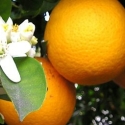BACK
Growing and Maintaining Fruit Trees


Nothing tastes as good as fruit plucked from a tree you have grown in your own orchard. If your garden is small, consider growing a dwarf fruit tree or two, a more compact variety such as the Ballerina apples which have a narrow, columnar shape, or growing in a container.
Fruit trees espaliered along a fence or trellis make a statement in the garden and can make the most of space available. They also can ripen earlier as the reflected heat from the wall reflects to warm up the developing fruit.
Let’s assume you have identified a sunny, free draining, sheltered spot for your chosen fruit trees. The closer you have to this the better the yeild. Click here for guidance about planting your trees.
Tips for success growing Fruit Trees -
• Remove all tags or twist-ties from your trees after planting as if left, these can strangle or ring-bark the limbs they’re on, as the tree grows.
• Weeds and grasses will compete with your fruit trees for nutrients – consider having a circle of plant-free ground between the tree trunk and the drip line (the outer edge of the tree canopy). Cover this “tree-circle” area with mulch or shredded bark to keep the weeds down, encourage healthy organisms to condition the soil and aid water retention. Your “tree-circle” provides space to add nutrition - fertilisers and/or organic matter.
• If you are using mulch/bark around your tree, it should not be touching the trunk because if there are any wounds in the trunk base or on the bark, harmful microbes can move from the damp mulch into the tree and may cause rotting or disease.
• Fertiliser - once spring blossoms and leaf nodes start to appear, add controlled or slow-release fertiliser to the soil surface - the feeder roots will be reaching out, away from the trunk, so add fertilisers into the tree-circle and as far out as the drip line. Once established, your trees should be fertilised every spring and summer. Little and often are the best rules.
• Irrigation - fruit trees do NOT like having wet feet (roots) or water-logged soils, so it is important not to over-water them. Water during dry spells when they are young, in the summer months, when there is little or no rainfall, water once or twice weekly.
• Spraying - for pest and disease prevention and control. Many pests live on trees, so to stop them from carrying over from one season to the next, spraying with an insecticide is essential; diseases such as curly leaf and other fungal disease are treated with a fungicide spray. The timing of spraying is important as some sprays can affect pollinators e.g. bees once flowers are open.
• In the winter spray with Copper Oxychloride and Conqueror oil, and then at least 2 weeks later spray Lime Sulphur. In early spring, just before budburst, spray once and then again 10-14 days later, spray with Copper Oxychloride. Note if it rains hard enough to wash off that first spray during that period, you may have to apply the second spray sooner.
• To protect pip-fruit (apples and pears) from codling moth, hang a moth pheromone trap in one of every 5 trees to attract and kill the male moths. If you are trapping lots of moths in spring, then you should consider spraying with an insecticide to eliminate the females.
• Pruning - most fruit trees can be pruned using instructions provided here: Citrus and Feijoa -prune only to shape your tree, remove dead /damaged branches or to open it up to light and allow better airflow. Prune late winter, except citrus in cooler areas where pruning is done before the first frosts.
• Harvesting - depending on the variety, it can take 2-3 years for a tree to become established and bear fruit; longer for some pears and nut trees. While many fruit trees are self-fertile, there are exceptions amongst the apples, avocado, plums, pears, nashis and cherries which will require a pollination partner. Check under the ‘How to’ section of our website for pollination partner information. e.g. Apple Pollinators
Other useful links Espalier Basics Home Orchard
BACK
HL Nurseries Limited t/a Wairere Nursery
826 Gordonton Road, R D 1, Hamilton 3281 Ph: (07) 824 3430 Email: